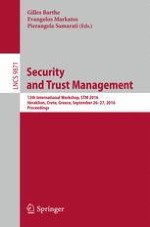2016 | Buch
Security and Trust Management
12th International Workshop, STM 2016, Heraklion, Crete, Greece, September 26-27, 2016, Proceedings
herausgegeben von: Gilles Barthe, Evangelos Markatos, Pierangela Samarati
Verlag: Springer International Publishing
Buchreihe : Lecture Notes in Computer Science
